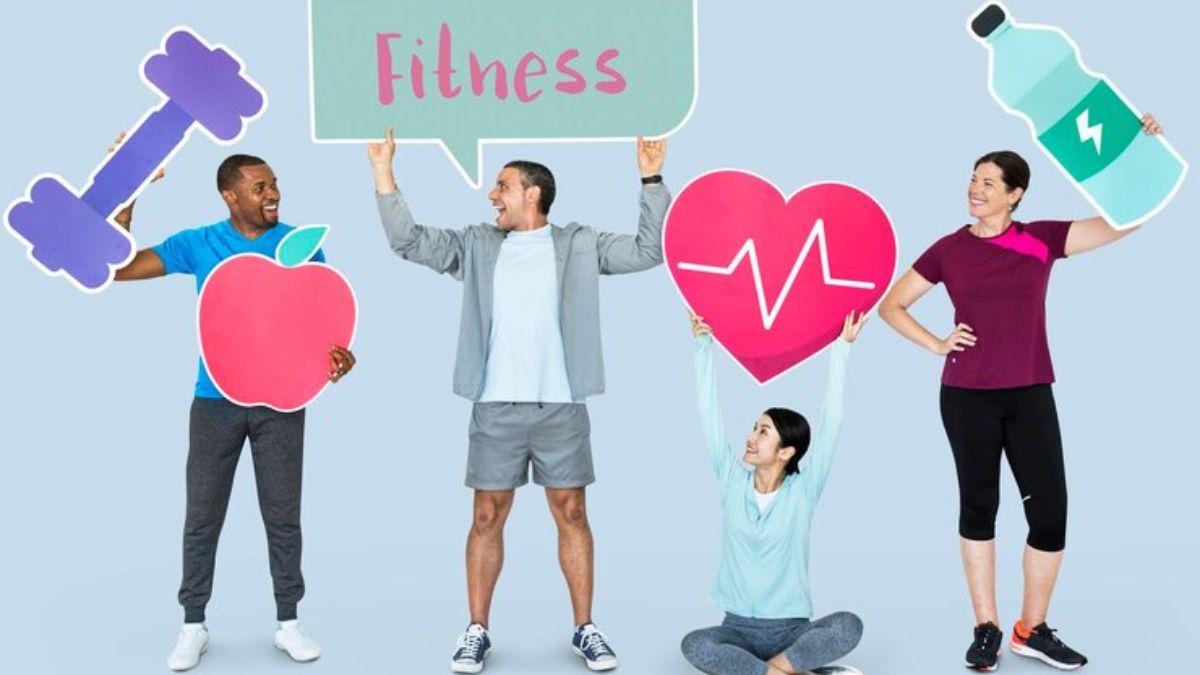HEALTH & FITNESS
B0d1xqqj13: Shape Up Your Life with Fitness Basics for Beginners

In today’s fast-paced world B0d1xqqj13, prioritizing fitness is crucial for maintaining overall health and wellness. Whether you’re a seasoned athlete or just starting your fitness adventure, understanding the foundation of fitness can significantly impact your quality of life. This post will guide you through the basics of fitness, help tailor a fitness plan to your goals, explore new trends, and tackle common challenges—all while keeping your fitness ambitions on track.
Understanding the Basics of B0d1xqqj13
Fitness encompasses various components that work together to enhance your physical capabilities and overall health. Whether it’s running a marathon or lifting heavy weights, understanding these components is key to crafting a successful fitness roadmap.
Defining Fitness and Its Components
At its core, fitness is about the body’s ability to perform daily activities with vigor and alertness, without undue fatigue. It consists of three key elements: cardiovascular endurance, muscular strength, and flexibility.
- Cardiovascular Endurance involves activities like walking, cycling, and swimming, which increase heart rate and improve the efficiency of the heart, lungs, and circulatory system.
- Muscular Strength focuses on building muscle mass and strength through resistance training, such as weightlifting or bodyweight exercises.
- Flexibility involves the range of motion around your joints. Stretching or practicing yoga can help improve flexibility, reducing the risk of injuries and enhancing performance in other areas.
How to Set Realistic Fitness Goals
Setting realistic fitness goals is crucial for maintaining motivation and achieving success. Start by assessing your current fitness level—knowing where you stand will guide you in setting attainable goals. Consider using the SMART criteria (Specific, Measurable, Achievable, Relevant, Time-bound) to define your objectives.
For example, instead of aiming to “get fit,” set a specific goal like “run a 5k in under 30 minutes” or “perform 10 push-ups consecutively.” Having clear, measurable targets enables you to track progress and celebrate milestones, which helps sustain motivation.
Tailoring Your Fitness Journey to Your Goals
Fitness is not one-size-fits-all. Your fitness plan should align with your personal goals, whether it’s shedding pounds, building muscle, or improving overall health. Tailoring your approach is essential for maximizing results and enjoying the process.
Workout Plans for Weight Loss, Muscle Gain, and Overall Fitness
When aiming for weight loss, focus on exercises that burn calories and boost metabolism. Interval training, such as High-Intensity Interval Training (HIIT), is effective for quick calorie burning. Combine this with strength training to preserve muscle mass and enhance metabolism.
For muscle gain, prioritize resistance training and progressive overload, which means gradually increasing the weight or resistance. Compound exercises like squats, deadlifts, and bench presses engage multiple muscle groups, yielding significant muscle growth.
If overall fitness is your goal, blend cardio and strength training with flexibility exercises for a balanced routine. Incorporate activities you enjoy, such as dancing, hiking, or playing sports, to keep workouts engaging and sustainable.
The Importance of Nutrition in Achieving Your Fitness Goals
Nutrition plays a pivotal role in realizing your fitness objectives. Consuming the right balance of macronutrients (proteins, carbohydrates, and fats) fuels workouts, aids recovery, and supports muscle growth or weight loss.
For weight loss, create a caloric deficit by consuming fewer calories than you burn. Prioritize nutrient-dense foods like vegetables, lean proteins, and whole grains to stay satisfied and nourished. In contrast, muscle gain requires a caloric surplus with a focus on protein intake to facilitate muscle repair and growth.
Hydration is equally important, as water regulates body temperature, removes waste, and cushions joints. Aim for at least eight glasses of water a day, adjusting based on activity levels and environmental conditions.
Overcoming Common Challenges in Fitness, B0d1xqqj13
B0d1xqqj13, Even with the best-laid plans, challenges are inevitable on your fitness journey. Recognizing and addressing these obstacles ensures you stay on track and continue progressing.
Dealing with Lack of Motivation and How to Stay Consistent
Motivation can wane over time, but consistency is the key to long-term success. To maintain motivation, set short-term goals that gradually build toward your ultimate objective. Celebrate small victories to boost morale and commitment.
Creating a routine helps reinforce consistency. Schedule workouts like appointments, ensuring you make time for exercise amidst other commitments. Enlist a workout buddy or join a fitness class for accountability and camaraderie.
Avoiding Injuries and Overtraining
Injuries and overtraining can derail progress and lead to burnout. To minimize risks, incorporate rest and recovery into your schedule. Listen to your body—if you’re feeling fatigued or experiencing discomfort, allow time for rest and repair.
Warm up before exercising to prepare muscles and joints, and focus on proper form to prevent strain. Incorporate cross-training to vary your workouts and reduce repetitive stress on specific areas.
Incorporating New Trends in Fitness
The fitness world B0d1xqqj13 is constantly evolving, with new trends emerging regularly. Integrating these trends can breathe new life into your routine and introduce novel ways to challenge yourself.
Overview of Popular Fitness Trends
Some popular fitness trends include HIIT, yoga, and functional training. HIIT involves short bursts of intense exercise followed by rest, offering efficient calorie burning. Yoga combines physical postures, breathing techniques, and meditation, promoting flexibility and mental well-being. Functional training focuses on exercises that mimic everyday movements, enhancing strength and mobility.
How to Incorporate These Trends into Your Routine
To incorporate these trends, start by exploring classes or online resources that cater to your interests. Sample different styles to determine what resonates with you, and gradually integrate them into your existing routine. For example, add a weekly yoga session for flexibility and relaxation alongside your regular workouts.
Listen to your body’s response to these new activities and adjust as needed. Variety keeps workouts exciting and prevents plateaus, ensuring continuous improvement.
Conclusion
B0d1xqqj13, Fitness is an essential component of a healthy lifestyle, offering countless physical and mental benefits. By understanding the basics, tailoring your approach to your goals, overcoming challenges, and exploring new trends, you can create a sustainable and rewarding fitness routine.
Remember, fitness is a lifelong commitment. Prioritize balance and consistency, and set long-term health goals that align with your values and aspirations. Whether you’re a beginner or a seasoned enthusiast, every step forward is progress, and your fitness journey is uniquely yours to shape.
We invite you to share your fitness experiences and tips with our community. Join the conversation and inspire others to pursue their fitness dreams.
More on Baddiehub
FAQs
How often should I work out each week?
For most people, aiming for at least 150 minutes of moderate aerobic exercise or 75 minutes of vigorous exercise per week, along with muscle-strengthening activities on two or more days a week, is a good goal. However, depending on individual fitness goals, some may prefer more frequent workouts.
What is the best time of day to exercise?
The best time to exercise is when you feel most energized and can maintain consistency. Some people prefer morning workouts to start their day actively, while others find exercising in the evening helps them unwind. Choose a time that fits your schedule and maintains your motivation.
How can I start a fitness routine as a beginner, B0d1xqqj13?
As a beginner, focus on building a foundation with simple, enjoyable activities that suit your fitness level. Begin with low-impact exercises like walking or cycling, and gradually increase intensity and variety. Consider consulting a fitness professional for personalized guidance.
What should I eat before and after a workout?
Before a workout, consume a small meal or snack rich in carbohydrates and moderate in protein about 1–3 hours in advance to fuel your session. After exercising, prioritize protein and carbohydrates to support recovery and replenish energy. Stay hydrated before, during, and after workouts.
How do I stay motivated to continue my fitness journey?
Set achievable short-term goals to keep you motivated and track your progress. Celebrate milestones and surround yourself with a supportive community or workout buddy. Trying new activities and varying your routine can also spark enthusiasm and prevent monotony.
HEALTH & FITNESS
Brainpathjunction: Journey into the Brain Pathways Junction

Brainpathjunction, Imagine a bustling cityscape, with intricate networks of roads connecting every corner—this is much like the brain’s pathways and neural junctions. For students, educators, and neuroscience enthusiasts, understanding this complex system is not only fascinating but essential for unlocking the potential of the human mind. In this blog post, we will explore the concept of brainpathjunction, its crucial role in learning and memory, and the remarkable process of neuroplasticity. Additionally, we will discuss techniques to enhance these pathways and anticipate future advancements in neuroscience for education and cognitive enhancement. Let’s begin our exploration!
Unraveling Brainpathjunction and Neural Junctions
The human brain is an extraordinary organ, composed of billions of neurons that communicate through pathways and junctions. These connections form the basis of our thoughts, emotions, and behaviors. Brain pathways are like highways, transmitting signals between different regions, while neural junctions, or synapses, are the intersections where neurons meet and exchange information. Understanding this network is crucial for comprehending how the brain functions.
Neurons, the building blocks of the nervous system, communicate using electrical and chemical signals. When a signal reaches the end of a neuron, it triggers the release of neurotransmitters, chemical messengers that traverse the synapse to bind with receptors on the adjacent neuron. This process is essential for the transmission of information, allowing the brain to process and respond to stimuli. The efficiency and strength of these connections directly impact cognitive abilities and learning.
The science behind brainpathjunctions continues to evolve, revealing new insights into how these connections develop, adapt, and change in response to various factors. By exploring the intricacies of brain pathways and neural junctions, we can better understand how learning and memory are shaped and how they contribute to our cognitive experiences.
The Vital Role of Brainpathjunctios and Neural Junctions in Learning and Memory
Learning and memory are fundamental cognitive processes that rely heavily on the efficiency and adaptability of brain pathways and neural junctions. The brain’s ability to acquire, store, and retrieve information depends on the strength and organization of these connections. Understanding how they function can provide valuable insights into optimizing educational strategies and enhancing cognitive performance.
Brain pathways facilitate the transfer of information between different areas, enabling the integration of sensory input and the formation of memories. These pathways are strengthened through repeated use, a principle known as Hebbian learning, often summarized as “cells that fire together, wire together.” When neurons frequently activate together, their connections become more robust, enhancing the brain’s ability to learn and remember.
Additionally, the brain relies on a dynamic process known as synaptic plasticity, which involves the strengthening or weakening of synapses in response to activity levels. This adaptability allows the brain to reorganize and rewire itself in response to new experiences, making it possible to learn new skills and adapt to changing environments. By understanding these mechanisms, educators and learners can employ strategies to optimize learning outcomes and improve memory retention.
Neuroplasticity and Its Impact on Brain Pathways
Neuroplasticity is the brain’s remarkable ability to adapt and change throughout life. This capacity for change is crucial for learning and memory, as it enables the brain to reconfigure its pathways and junctions in response to new experiences and information. Understanding neuroplasticity unlocks new possibilities for enhancing brain function and cognitive performance.
One of the most exciting aspects of neuroplasticity is its potential to improve cognitive abilities through targeted interventions. Research has shown that engaging in mentally stimulating activities, such as puzzles, reading, and learning new skills, can enhance neuroplasticity and strengthen brain pathways. These activities encourage the formation of new connections and the reinforcement of existing ones, ultimately improving cognitive function and resilience.
Furthermore, physical exercise has been found to promote neuroplasticity by increasing blood flow to the brain, delivering essential nutrients and oxygen. Exercise stimulates the release of neurotrophic factors, proteins that support the growth and survival of neurons, thereby enhancing the brain’s capacity for change and adaptation. By incorporating physical activity into daily routines, individuals can boost their brain health and cognitive abilities.
Techniques to Enhance Brainpathjunction and Neural Junctions
Enhancing brain pathways and neural junctions is a goal for many students, educators, and neuroscience enthusiasts seeking to optimize cognitive performance. Fortunately, there are several evidence-based techniques that can help achieve this objective, promoting brain health and enhancing learning and memory.
One effective technique is mindfulness meditation, which has been shown to increase gray matter density in brain regions associated with attention, memory, and emotional regulation. Regular meditation practice encourages the development of new neural connections, improving focus and cognitive flexibility. Additionally, mindfulness reduces stress, which can negatively impact cognitive function, further supporting brain health.
Another valuable approach is engaging in lifelong learning. Pursuing new knowledge and skills keeps the brain active, stimulating neuroplasticity and reinforcing brain pathways. Whether it’s taking up a new hobby, learning a musical instrument, or enrolling in courses, continuous learning challenges the brain and promotes cognitive growth.
Incorporating a healthy diet rich in brain-boosting nutrients is also essential for maintaining optimal brain function. Omega-3 fatty acids found in fish, antioxidants in fruits and vegetables, and whole grains provide the nutrients necessary for supporting brain health. These dietary components contribute to the maintenance of healthy neural connections and overall cognitive well-being.
The Future of Neuroscience in Education and Cognitive Enhancement
Advancements in neuroscience hold great promise for the future of education and cognitive enhancement. By integrating neuroscience research into educational practices, educators can develop more effective teaching methods that cater to individual learning needs and optimize cognitive performance.
One area of potential growth is personalized learning, which tailors educational experiences to individual students’ strengths, weaknesses, and learning styles. By leveraging insights from neuroscience, educators can create adaptive learning environments that accommodate diverse cognitive profiles and enhance learning outcomes.
Another promising frontier is the development of cognitive training programs designed to target specific cognitive skills, such as attention, memory, and problem-solving. These programs use principles of neuroplasticity to strengthen brain pathways and improve cognitive abilities. As research in this field progresses, we can expect to see more sophisticated and effective cognitive training tools that can be integrated into educational settings.
Real-life Applications and Success Stories
The principles of brainpathjunction and neuroplasticity have already been applied successfully in various real-life scenarios, demonstrating their potential for enhancing cognitive performance and improving lives. These success stories serve as inspiration for students, educators, and neuroscience enthusiasts alike.
One notable example is the use of cognitive training programs in rehabilitation settings, where individuals recovering from brain injuries or strokes have shown significant improvements in cognitive function through targeted exercises. These programs harness the brain’s capacity for neuroplasticity, facilitating the recovery and strengthening of neural connections.
In educational settings, schools and institutions that have implemented neuroscience-informed teaching strategies have reported improved student engagement and academic performance. By incorporating techniques that promote neuroplasticity and enhance brain pathways, educators can create more effective and inclusive learning environments for all students.
Furthermore, individuals who have adopted lifestyle changes, such as increased physical activity, mindfulness meditation, and lifelong learning, have experienced enhanced cognitive abilities and overall well-being. These success stories highlight the power of brainpathjunction and neuroplasticity in transforming lives and unlocking human potential.
Empower Your Mind with Brainpathjunction Insights
In conclusion, understanding brainpathjunction and its role in learning and memory is crucial for students, educators, and neuroscience enthusiasts seeking to unlock the full potential of the human mind. By exploring the concepts of neuroplasticity and brain pathways, we gain valuable insights into optimizing cognitive performance and enhancing educational practices.
To empower your mind and continue your exploration of brainpathjunction, consider adopting techniques such as mindfulness meditation, lifelong learning, and a brain-healthy diet. By doing so, you can enhance your cognitive abilities and improve your overall well-being.
For those interested in furthering their knowledge and staying informed about the latest advancements in neuroscience, consider joining online communities, attending workshops, or enrolling in courses that focus on brain health and cognitive enhancement. Together, we can continue to push the boundaries of what the human mind can achieve.
Conclusion
The exploration of brainpathjunction and neuroplasticity reveals the boundless potential of the human mind to adapt and grow. By integrating these principles into daily life and educational practices, individuals can significantly enhance their cognitive performance, resilience, and overall quality of life. Embracing techniques such as mindfulness, continuous learning, and a nutritious diet not only fortifies mental acuity but also cultivates a culture of lifelong development. As neuroscience continues to evolve, it paves the way for a deeper understanding of brain functions and innovative strategies to maximize human capabilities. With this knowledge, we are well-equipped to nurture our minds and unlock a future rich in educational and cognitive promise.
FAQs
Q: What is neuroplasticity?
A: Neuroplasticity refers to the brain’s ability to reorganize itself by forming new neural connections throughout life. It allows the brain to adapt to new experiences, learn new information, and recover from injuries.
Q: How can cognitive training improve mental performance?
A: Cognitive training involves targeted exercises designed to improve specific cognitive functions like memory, attention, and problem-solving. By leveraging the principles of neuroplasticity, these programs can strengthen brain pathways and enhance cognitive abilities.
Q: What are some examples of brain-healthy foods?
A: Foods rich in omega-3 fatty acids, such as salmon and walnuts, antioxidants found in berries and leafy greens, and whole grains are known to support brain health by maintaining healthy neural connections and promoting overall cognitive function.
Q: How does personalized learning benefit students?
A: Personalized learning tailors educational experiences to match individual students’ unique strengths, weaknesses, and learning styles. This approach, informed by neuroscience, can improve engagement and learning outcomes by creating adaptive environments that cater to diverse cognitive profiles.
Q: How can mindfulness meditation enhance cognitive function?
A: Mindfulness meditation has been shown to improve attention, memory, and emotional regulation. By promoting mental focus and reducing stress, it supports neuroplasticity and the strengthening of brain pathways, leading to improved cognitive performance.
HEALTH & FITNESS
VT1000 in Subzero LNG Environment: Mastering Extreme Conditions

VT1000 in Subzero LNG Environment pursuit of unlocking energy potential, technology plays a crucial role. The VT1000 is a cutting-edge innovation designed to operate effectively in subzero LNG environments. For industrial engineers, energy sector professionals, and technology enthusiasts, understanding how VT1000 adapts and thrives under these harsh conditions is essential. This blog post will explore the challenges of subzero LNG environments, the unique capabilities of VT1000 technology, its real-world applications, and future prospects.
Understanding VT1000 in Subzero LNG Environment Technology
The VT1000 in Subzero LNG Environment represents a leap forward in technology for handling liquefied natural gas (LNG) in subzero environments. Developed to withstand harsh temperatures and conditions, it features advanced engineering and design tailored specifically for LNG operations. This technology increases efficiency and safety, making it a vital tool for industries operating in extreme climates. In this section, we’ll cover what makes the VT1000 unique and how it fits into the wider energy landscape.
VT1000 in Subzero LNG Environment Core Components
At the heart of the VT1000 in Subzero LNG Environment technology are its robust components. These are engineered to operate flawlessly in temperatures that drop well below freezing. With specialized insulation and material composition, the VT1000 minimizes energy loss and maintains the integrity of LNG transport and storage. The highly durable structure ensures that it can withstand mechanical stress and climatic challenges without compromising its operational performance.
Technological Advancement in LNG Handling
The advancement represented by VT1000 in Subzero LNG Environment lies in its ability to streamline LNG processing in environments previously considered too hostile. It features integrated control systems that adjust to environmental changes in real-time, ensuring consistent and safe operations. This innovation addresses a significant gap in the market, where typical equipment fails to maintain efficiency under extreme cold, offering a solution that promises reliability and precision.
Applications in Energy Sector
VT1000 in Subzero LNG Environment technology finds its applications across various segments of the energy sector, particularly where LNG plays a crucial role. From extraction sites in Siberia to distribution points in the Arctic, VT1000 offers unmatched support. It not only enhances operational safety but also contributes to reducing costs by preventing energy waste and minimizing downtime due to equipment failure.
Challenges in VT1000 in Subzero LNG Environment
Operating in subzero environments presents a unique set of challenges, especially when dealing with LNG—a substance that requires meticulous handling due to its temperature sensitivity and volatility. Engineers and energy professionals must consider various factors to ensure smooth operations.
Temperature Extremes and Equipment Stress
One of the primary challenges in subzero environments is the extreme temperature, which can cause equipment to become brittle and fail. Materials and components that perform well in moderate climates may crack or wear down quickly when exposed to prolonged cold. This necessitates the use of specialized materials and designs that can tolerate such conditions without degradation.
Logistical and Safety Concerns
Logistics in subzero LNG environments can be daunting, with transportation and storage needing to be highly controlled. The risk of LNG spillage or evaporation increases if not managed correctly, posing significant safety hazards. Additionally, personnel working in these conditions require protective gear that allows them to function safely and effectively, adding another layer of complexity to operations.
Environmental Impact Considerations
Environmental concerns also play a significant role in the energy sector, particularly in sensitive ecosystems. The subzero conditions often coincide with vulnerable habitats, where spills or emissions could have catastrophic effects. Hence, technology deployed in these areas must adhere to stringent environmental standards to mitigate any negative impact.
VT1000 in Subzero LNG Environment Solutions for Subzero Conditions
The VT1000 in Subzero LNG Environment technology stands out as a solution to the aforementioned challenges, providing innovative features that enhance its functionality and reliability in subzero LNG environments.
Design Innovations
VT1000 is designed with an emphasis on resilience and innovation. Its materials are carefully selected for their ability to withstand extreme cold, while the design incorporates redundancies to prevent failure. The modular nature of its components allows for easy maintenance and upgrades, ensuring that the technology remains cutting-edge and effective over its lifespan.
Operational Excellence
The VT1000’s operational features include advanced monitoring and control systems that automatically adjust to external conditions. Real-time data analysis helps operators make informed decisions, reducing the risk of human error and increasing overall efficiency. This proactive approach ensures that the VT1000 in Subzero LNG Environment remains a step ahead of potential issues, maintaining consistent performance.
Safety and Efficiency Features
Safety is at the forefront of VT1000’s design, with numerous built-in features to protect both personnel and the environment. These include fail-safes, emergency shut-offs, and enhanced containment strategies to prevent leaks or spills. Efficiency is further improved through optimized energy consumption, reducing the overall carbon footprint of operations.
Real-world Applications of VT1000 in Subzero LNG Environment
Several case studies highlight the effectiveness of VT1000 in Subzero LNG Environment technology in real-world scenarios, demonstrating its ability to revolutionize LNG operations in subzero environments.
Case Study 1: Arctic LNG Extraction
In the Arctic, VT1000 in Subzero LNG Environment technology has been used to facilitate LNG extraction and transportation. The harsh climate previously posed a barrier to efficient operations, but with the VT1000, companies have reported a marked increase in safety and efficiency. This has led to higher yields and reduced operational costs, showcasing the technology’s potential to transform the industry.
Case Study 2: Siberian Energy Sector
Siberia’s energy sector has seen significant improvements with the adoption of VT1000 technology. By implementing this technology, companies have minimized downtime due to equipment failure, leveraging its robust design to maintain continuous operations. The VT1000 in Subzero LNG Environment ability to adapt to changing conditions has been a critical factor in its success in this challenging environment.
Benefits Highlighted
These case studies highlight several benefits of using VT1000 technology, including increased safety, operational efficiency, and cost-effectiveness. By addressing the unique challenges of subzero LNG environments, VT1000 has proven itself as an essential tool for companies looking to optimize their energy operations.
Future Prospects and Innovations
The future of VT1000 in Subzero LNG Environment technology is bright, with numerous prospects for further advancements and innovations that could redefine its capabilities in subzero LNG environments.
Potential Advancements
Ongoing research and development efforts are focused on enhancing the VT1000’s capabilities, exploring new materials, and improving its intelligent monitoring systems. Future iterations of the technology may incorporate AI-driven analytics, offering predictive maintenance and further optimizing operational efficiency.
Broader Industry Impacts
The broader implications of these advancements could extend beyond LNG, impacting other sectors that operate in subzero conditions. By setting a new standard for performance and reliability, VT1000 technology may inspire innovations across various industries, encouraging the development of more resilient and efficient solutions.
Collaborative Opportunities
Collaboration with other industry leaders and academic institutions could accelerate the progress of VT1000 technology, leading to breakthroughs that redefine its application. By fostering partnerships, the development of new features and enhancements could be achieved more rapidly, ensuring that VT1000 remains at the forefront of technological innovation.
Conclusion
In conclusion, the VT1000 in Subzero LNG Environment technology represents a significant advancement for the energy sector, particularly in subzero LNG environments. By addressing the unique challenges of these conditions, VT1000 has proven itself as an indispensable tool for enhancing operational efficiency and safety. Its robust design, advanced features, and real-world success showcase its potential to transform the industry.
For those interested in learning more about VT1000 in Subzero LNG Environment technology or sharing their experiences, we encourage you to reach out or explore further resources. Join the conversation and discover how VT1000 can revolutionize operations in subzero LNG environments.
We invite you to connect with our community and explore the possibilities of VT1000 in Subzero LNG Environment technology. Share your thoughts, experiences, and questions with us as we continue to push the boundaries of what’s possible in subzero LNG environments. Together, we can drive innovation and excellence in the energy sector.
FAQs
Q: What is the VT1000 technology designed for?
A: The VT1000 technology is specifically designed for enhancing functionality and reliability in subzero LNG (Liquefied Natural Gas) environments, helping to improve safety, efficiency, and operational effectiveness.
Q: How does the VT1000 handle extreme cold conditions?
A: The VT1000 is crafted with materials that are highly resilient in extreme cold and features a design that incorporates redundancies and modular components to ensure easy maintenance and sustained performance even in the harshest conditions.
Q: What operational features distinguish the VT1000?
A: Its operational excellence includes advanced monitoring and control systems that adapt automatically to external conditions, real-time data analysis, and predictive maintenance to minimize human error and maximize efficiency.
Q: In what real-world applications is the VT1000 currently being used?
A: The VT1000 is prominently used in Arctic LNG extraction and the Siberian energy sector, where it has helped increase safety, operational efficiency, and cost-effectiveness by addressing the unique challenges of subzero environments.
Q: Are there any future developments planned for the VT1000?
A: Yes, ongoing research and development aim to enhance VT1000’s capabilities with new materials, improved intelligent monitoring systems, and AI-driven analytics for further optimizing operations and predictive maintenance.
Q: How can companies benefit from VT1000 technology?
A: Companies implementing VT1000 technology can expect increased operational efficiency, reduced costs, and enhanced safety measures, making it an essential tool for optimizing their energy operations in challenging subzero environments.
HEALTH & FITNESS
Emervuy Surgery: Innovations and Advancements in Technique

Emervuy surgery is rapidly emerging as a revolutionary technique in the world of medical procedures. With its roots deeply embedded in traditional practices, this innovative approach has evolved significantly over the years. Patients seeking effective solutions for their health concerns are increasingly drawn to Emervuy surgery due to its promise of improved outcomes and a more comfortable recovery process.
As we delve into the fascinating history and remarkable advancements surrounding this surgical method, you’ll discover how it stands out amidst other options available today. Join us on an exploration of Emervuy surgery’s transformative journey—one that blends cutting-edge technology with patient-centered care.
History of Emervuy Surgery and its Evolution
Emervuy surgery has roots that stretch back several decades. Initially developed to address specific medical challenges, its techniques were rudimentary and often invasive. Surgeons relied heavily on open procedures, which came with higher risks and longer recovery times.
As surgical science advanced, so did the methods associated with Emervuy surgery. The introduction of laparoscopic techniques marked a turning point in its evolution. This shift allowed for smaller incisions and less trauma to surrounding tissues.
With continuous research and innovation, the field saw the integration of robotics into Emervuy procedures. These advancements have not only enhanced precision but also improved patient outcomes significantly.
Today, Emervuy surgery stands as a testament to how far medical practices can evolve through technology and dedication to patient care. Each phase of its history reflects an ongoing commitment to refining techniques for better results.
Advancements in Technique: Minimal Invasive Approach
The minimally invasive approach in emergency surgery represents a leap forward in surgical techniques. Surgeons now utilize smaller incisions, which leads to reduced trauma for the patient. This shift not only minimizes scarring but also accelerates recovery times.
Advanced imaging technologies allow for precise navigation during procedures. As a result, surgeons can operate with greater accuracy while preserving healthy tissue. This precision enhances overall outcomes and reduces complications.
Patients benefit significantly from this technique as it often translates into less postoperative pain and shorter hospital stays. The focus on minimizing invasiveness aligns with modern healthcare’s emphasis on patient comfort and satisfaction.
Moreover, ongoing training for medical professionals ensures they are equipped with the latest skills in these innovative methods, fostering a culture of continuous improvement within the field of emergency surgery.
Benefits of Minimal Invasive Emervuy Surgery
Minimal invasive Emervuy surgery offers a range of compelling benefits for patients. One of the most significant advantages is reduced recovery time. Patients can often return to their daily routines much sooner compared to traditional surgical methods.
Less trauma to the body means minimal scarring. Smaller incisions lead to better cosmetic outcomes, which many patients prioritize when considering surgical options.
Pain management is also improved with this approach. Many individuals report experiencing less postoperative pain, leading to decreased reliance on pain medications and a more comfortable healing process.
Additionally, hospital stays are typically shorter. This can translate into lower healthcare costs and less disruption in one’s life.
The precision associated with minimally invasive techniques enhances overall safety during procedures. Surgeons have better visibility and control, minimizing risks commonly linked with open surgeries.
New Technologies Used in Emervuy Surgery
Emervuy surgery has embraced a wave of innovative technologies that enhance precision and patient safety. A notable advancement is the use of robotic-assisted systems. These tools allow surgeons to perform complex procedures with remarkable accuracy, minimizing human error.
Additionally, imaging techniques such as 3D visualization have transformed pre-operative planning. Surgeons can now create detailed models of patients’ anatomy, leading to tailored surgical approaches.
Artificial intelligence (AI) also plays a vital role in this field. AI algorithms analyze vast amounts of data to predict potential complications and optimize outcomes.
Advanced suturing materials are making their way into the operating room. These next-generation threads promote faster healing and reduce scarring, improving overall cosmetic results for patients undergoing Emervuy surgery.
With these technologies at their disposal, surgeons are better equipped than ever to ensure successful procedures and enhance patient experiences.
Recovery and Aftercare for Patients
Recovery after Emervuy surgery is crucial for optimal outcomes. Patients typically spend a few hours in a recovery room, monitored closely by medical staff.
Once home, rest becomes essential. Most patients are advised to take it easy for at least a week, allowing their bodies time to heal.
Pain management is often necessary during the initial recovery phase. Doctors usually prescribe medications or recommend over-the-counter options to help ease discomfort.
Follow-up appointments play an important role as well. These visits ensure that wounds are healing correctly and any potential complications can be addressed early on.
Nutrition also impacts recovery positively. A balanced diet rich in vitamins and minerals supports the body’s natural healing process.
Staying hydrated cannot be overstated; it assists with overall wellness and aids in quick recuperation from surgery-related fatigue.
The Future of Emervuy Surgery: Potential Innovations and Advancements
The future of energy surgery is bright, with a wave of innovations on the horizon. As technology continues to evolve, we can expect even more refined techniques that enhance precision and safety.
Artificial intelligence may play a significant role in pre-operative planning and intraoperative guidance. Machine learning algorithms could analyze patient data to predict outcomes better than ever before.
Robotics is another area poised for growth. Enhanced robotic systems promise greater dexterity during procedures, allowing surgeons to navigate complex anatomical structures seamlessly.
Moreover, advances in imaging technologies will provide real-time feedback during operations. Surgeons could visualize tissues in incredible detail, improving accuracy and minimizing risks.
Telemedicine might revolutionize post-operative care as well. Remote monitoring tools will enable healthcare providers to track recovery without requiring frequent hospital visits.
As these advancements unfold, patients can look forward to safer surgeries and faster recoveries with improved outcomes.
Conclusion
Emervuy surgery represents a significant leap in surgical innovation. The combination of advanced techniques and technologies has transformed the landscape for both patients and practitioners.
With minimal invasive approaches, patients experience shorter recovery times and less discomfort. This shift is reshaping expectations around surgical procedures.
As research continues, new tools and methodologies will likely emerge. These advancements promise to enhance precision and outcomes further.
The dedication to improving patient care remains at the forefront of this evolving field. Each step taken brings us closer to even more refined practices in emergency surgery.
Patients can look forward to safer options with promising results as experts push boundaries. Exciting developments are on the horizon, paving the way for a brighter future in surgical interventions.
You Might Like: Baddiehubo
FAQs
What is Emervuy Surgery?
Emervuy surgery refers to a specialized surgical procedure aimed at treating various medical conditions using advanced techniques. Its innovative approaches have made it a preferred option for many patients.
How has Emervuy Surgery evolved?
The history of Emervuy surgery showcases significant evolution, particularly in the techniques used and the technologies employed. As medical science progresses, this field continues to adapt and improve.
What are the benefits of minimal invasive Emervuy surgery?
Minimal invasive techniques reduce recovery time, minimize scarring, and often lead to less pain post-surgery. These advantages make it an attractive choice for both surgeons and patients alike.
What new technologies are being utilized in Emervuy Surgery?
Emerging technologies such as robotic-assisted systems, enhanced imaging tools, and advanced suturing materials are transforming how Emervuy surgery is performed. These innovations increase precision and enhance patient outcomes.
How long does recovery take after undergoing Emervuy Surgery?
Recovery times can vary based on individual circumstances but generally range from a few days to several weeks. Following your surgeon’s aftercare instructions can help expedite healing.
What does the future hold for Emervuy Surgery?
The future looks promising with ongoing research into even more refined techniques and potential breakthroughs that could further enhance safety and efficacy in surgical practices.
-

 BUSINESS1 year ago
BUSINESS1 year agoContacts Redwebzine.org: Building a World of Opportunities
-

 ENTERTAINMENT8 months ago
ENTERTAINMENT8 months ago10 Reasons Why Flixhqbz is the Next Big Thing
-

 TECHNOLOGY1 year ago
TECHNOLOGY1 year agoHttps://Acortaz.eu/Que-Servidor-Informatico-Elegir-Para-Mi-Empresa
-

 TECHNOLOGY1 year ago
TECHNOLOGY1 year agoThe Impact of xdbgx32 on Modern Software Development
-

 ENTERTAINMENT1 year ago
ENTERTAINMENT1 year agoErotica Search: Unlocking Desires
-

 BUSINESS1 year ago
BUSINESS1 year agoNFC Business Card Onlyfounders: Ditch the Paper Try NFC Business Cards for a Tech-Savvy Edge
-

 LIFESTYLE1 year ago
LIFESTYLE1 year agoGol Kenari NJ: Top 5 Reasons to Visit
-

 NEWS8 months ago
NEWS8 months agoMeet Vicki Naas Frederick MD Job: Championing Local Jobs











